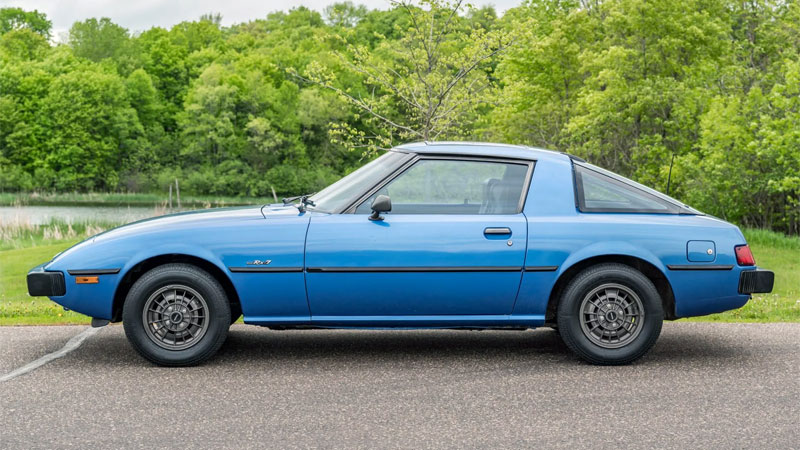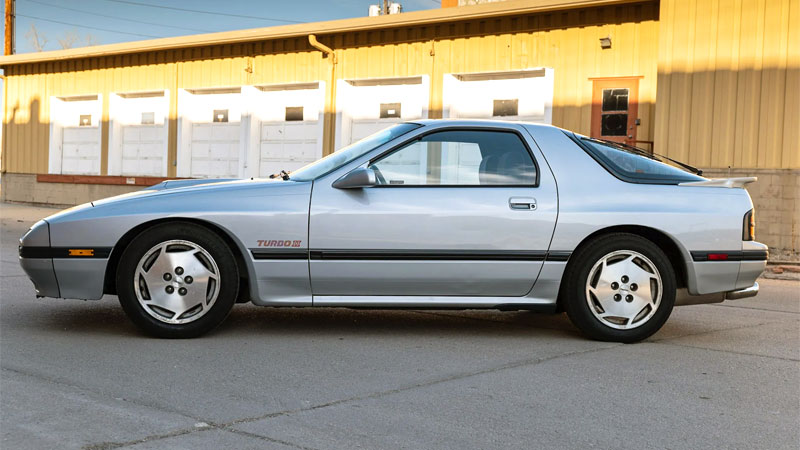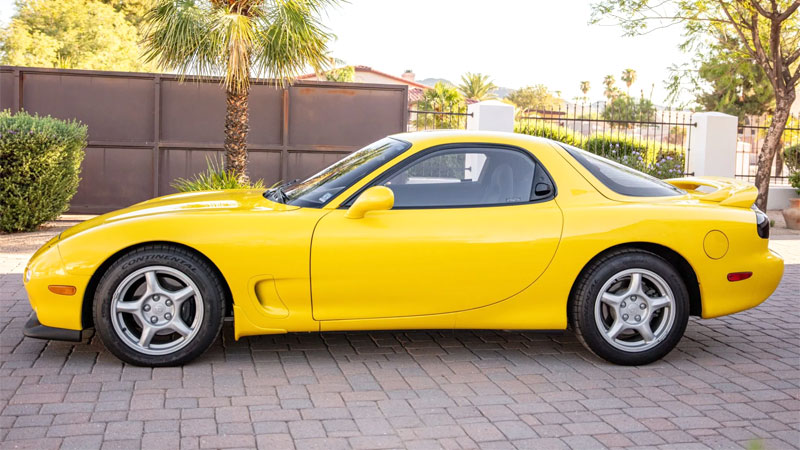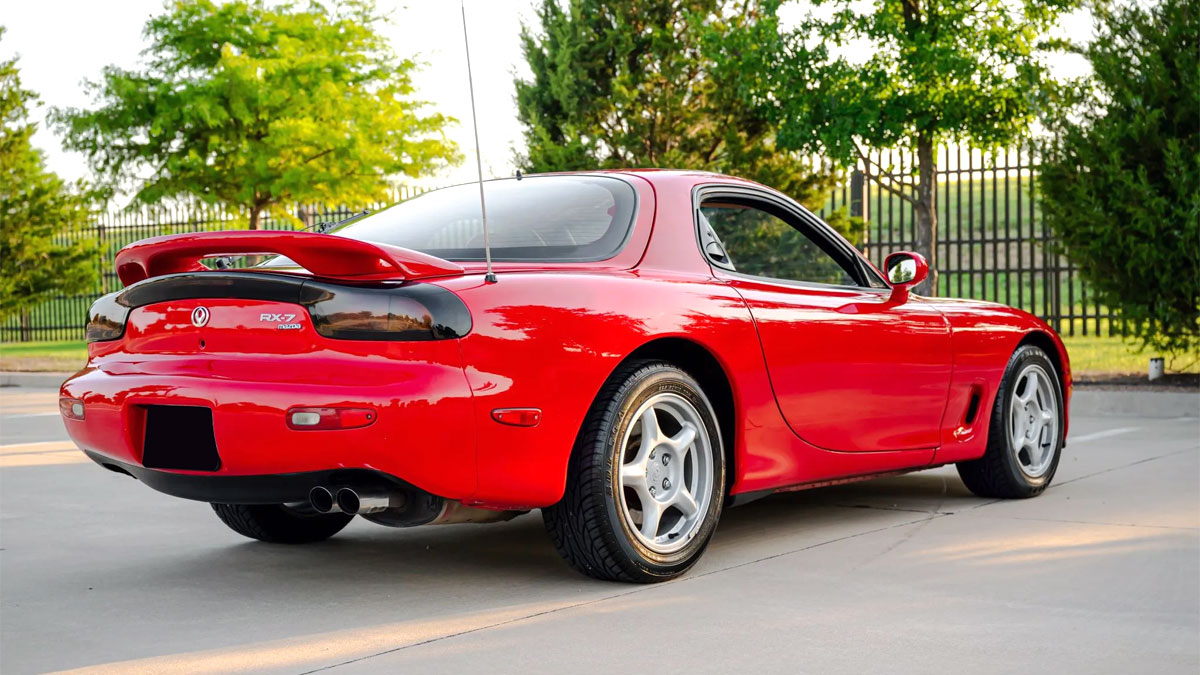When the Mazda RX-7 debuted in 1978 as the first-generation sports car to feature the innovative Wankel rotary engine, it captured the automotive world’s attention and imagination.
For over two decades spanning three model generations, the lightweight RX-7 delivered unparalleled smoothness and high-RPM power in an affordable package focused squarely on agile handling and driving dynamics instead of brute horsepower alone.
With a “front mid-engine” and rear-wheel drive configuration providing exceptional balance and control to match the powerplant’s free-revving character, the RX-7 became the everyman’s sports car, cementing Mazda’s reputation for Wankel engine expertise and clever engineering committed to the pure sports car experience.
We trace this high-performance icon’s history and legacy from its origins to its discontinuation and to recent efforts hoping to resurrect the storied nameplate.
- Known for: Smooth, high-revving rotary engine, agile handling, affordable, lightweight sports car package focused on the pure driving experience.
- First Model Year: 1978
- Final Model Year: 1995 (in the US)
- Original Price in 1978: $7,195 (around $34k USD today)
- Total Sold in the US: 542,227 [source]
See Also – Toyota MR2 History
What Does ‘RX-7’ Stand For?
Mazda’s naming convention for their rotary-engine powered vehicles has led to some debate among automotive historians and enthusiasts over the years regarding what “RX-7” specifically signifies for the pioneering sports car.
Some early reports assumed the “RX” designation referred to Mazda’s intent to “Rotary Export” these specialty engines abroad. However, it has since been clarified that the proper definition behind the “RX-7” nomenclature is “Rotary Experimental 7”.
The “Rotary Experimental” portion refers directly to the specialty Wankel rotary engine that powers the car. And the “7” denotes the fact that this engine was the seventh-generation developmental rotary engine project undertaken by Mazda engineers.
So while the “RE” may have been misinterpreted as “Rotary Export” in the past, Mazda itself has set the record straight – RX stands for Rotary Experimentation within their engine development programs, followed by the generation number that ended up powering their rotary sports cars.
Mazda RX-7 Generations
Over its distinguished tenure, the Mazda RX-7 came into its own through three pivotal generations, each advancing Mazda’s rotary sports car formula in exciting ways.
First Generation – SA/FB (1978-1985)

When the first-generation Mazda RX-7 debuted in 1978, it introduced the world to Mazda’s groundbreaking new Wankel rotary engine design in an exciting and affordable sports car package.
Known by Mazda chassis codes SA for 1978-1980 models and FB starting with the 1981 model year’s facelift, the RX-7 was designed to offer the excitement of a sports car with the unique characteristics of a rotary engine, all at a price point accessible to a wider range of customers.
The RX-7 was powered by Mazda’s 12A rotary engine, a 1.1-liter unit that was compact and lightweight, contributing to the car’s excellent handling and balance. This engine was capable of producing around 100 horsepower in its initial form, with later models seeing slight increases in power output.
The rotary engine’s smoothness and ability to rev high made the RX-7 a joy to drive, and it quickly gained a reputation for its spirited performance.
The car’s styling was also a major draw, with its long hood, short rear deck, and distinctive pop-up headlights, it had a classic sports car profile that has remained appealing over the years. The design also prioritized aerodynamics, which helped with both performance and fuel efficiency.
Handling was one of the RX-7’s strong points, thanks to its light weight, well-tuned suspension, and near-perfect weight distribution. The first-gen RX-7 used a live rear axle with Watt’s linkage and a four-wheel independent suspension setup that provided responsive and engaging driving dynamics. This made the RX-7 a favorite among driving enthusiasts and a competitive choice for amateur and professional racing.
Throughout its production run, the RX-7 saw various updates and limited edition models, including the GSL-SE, which came equipped with a larger and more powerful fuel-injected 13B rotary engine (good for 135 hp), four-wheel disc brakes, and improved suspension components.
The first-generation RX-7 is remembered fondly by car enthusiasts for its unique combination of style, performance, and the novel experience of driving a rotary-powered vehicle. The model laid the groundwork for Mazda’s continued innovation with the rotary engine and set the stage for the future success of the RX-7 nameplate.
See Also – The History of the BMW Z8
Second Generation – FC (1986-1992)

Produced from 1986 to 1992, the 2nd gen is known as the FC and represents a significant evolution over its predecessor. This generation brought substantial changes in design, performance, and technology, reflecting Mazda’s commitment to the sports car market.
Design-wise, the FC RX-7 adopted a more modern and rounded aesthetic, moving away from the angular lines of the first generation. The updated look was partially influenced by the Porsche 944 and featured pop-up headlights, a more pronounced hood, and a hatchback design that provided better utility without sacrificing the car’s sporty profile.
It maintained the 2+2 seating configuration, though like many sports cars, the rear seats were quite small.
Under the hood, Mazda continued to develop the Wankel rotary engine, introducing the naturally aspirated 13B-RE and the turbocharged 13B-T. These engines offered improved performance and efficiency over the first generation’s 12A.
The naturally aspirated version produced around 146 horsepower, while the turbocharged models could produce upwards of 182 horsepower, with later Turbo II models reaching around 200 horsepower. This increase in power significantly improved acceleration and top speed, making the FC a more capable sports car.
Handling was further refined in the second-generation RX-7. Mazda introduced a more sophisticated suspension system that included a unique “Dynamic Tracking Suspension System” in some models, which featured a passive rear-wheel steering system to improve cornering performance. The FC also featured disc brakes all around, providing better stopping power to match its increased performance.
The interior of the FC RX-7 saw upgrades as well, with more modern and higher-quality materials, improved ergonomics, and additional features that increased driver comfort and convenience. The dashboard and center console were redesigned to be more driver-focused, and higher trim levels offered amenities like leather upholstery, a sunroof, and advanced audio systems.
In terms of variants, the second-generation RX-7 offered several notable models, including the convertible version introduced in 1988, which expanded the car’s appeal. The Turbo II became the performance flagship, boasting a more powerful engine, upgraded brakes, and suspension, as well as an available limited-slip differential.
Overall, the second-generation Mazda RX-7 FC represented a more mature and sophisticated iteration of the RX-7 concept. It balanced everyday usability with the performance expected from a sports car, all while retaining the unique characteristics of the rotary engine.
Third Generation – FD (1993-1995)

The third-generation Mazda RX-7, produced from 1993 to 1995 in the United States (and until 2002 in Japan), is known as the FD and is often regarded as the pinnacle of the RX-7 series. This generation represented a significant leap forward in performance, technology, and design, making it one of the most celebrated Japanese sports cars of its era.
The FD RX-7 featured a sleek and aerodynamic body that was a departure from the boxier shapes of the ’80s. The design was modern and timeless, with smooth lines, an aggressive stance, and the continuation of the iconic pop-up headlights.
The car had a lightweight construction, with extensive use of aluminum and other weight-saving materials to keep the curb weight down, which contributed to its exceptional handling characteristics.
Powering the FD was the 13B-REW rotary engine, a sequentially turbocharged 1.3-liter unit that delivered smooth and linear power. In the US market, this engine produced around 255 horsepower, allowing the RX-7 to accelerate from 0 to 60 mph in under 5 seconds, a remarkable feat at the time.
The twin-turbo system was designed to provide a broad power band, with the first turbo providing boost at lower RPMs and the second kicking in at higher RPMs to minimize turbo lag.
Handling was a key focus for the FD RX-7, and it featured a sophisticated double-wishbone suspension setup at all four corners. The car’s light weight, perfect front-to-rear weight distribution, and low center of gravity allowed for nimble and precise handling that could rival much more expensive sports cars.
This generation also came equipped with a Torsen limited-slip differential and ventilated disc brakes, further enhancing its performance credentials.
Inside, the FD RX-7’s cabin was driver-centric, with supportive bucket seats, a well-placed gear shifter, and an instrument panel that wrapped around the driver. The interior design was minimalist but functional, with an emphasis on the driving experience rather than luxury.
The FD was also notable for its active aerodynamics, including a rear spoiler that would adjust its angle based on speed to optimize downforce, and an optional front air dam that could lower at high speeds to reduce lift.
The 3rd gen RX-7 offered an unmatched driving experience. Its combination of power, agility, and driver engagement has made it a legend in automotive circles. The car’s popularity has endured, and it remains a highly desirable model for enthusiasts and collectors alike, often commanding high prices in the used car market.
The final few years of RX-7’s legacy is one of a no-compromise sports car that pushed the boundaries of what was possible with a rotary engine. It encapsulated the spirit of Mazda’s Zoom-Zoom philosophy and left a lasting impact on the history of performance cars.
Why Was the Mazda RX-7 Discontinued?
Sales of the RX-7 began to decline in the 1990s, partly due to the increasing cost of the vehicle. The RX-7’s price had risen significantly since its introduction, and by the time the third generation (FD) was in production, it was competing with more affordable sports cars as well as higher-end models.
This made it a tougher sell for a niche market that was already shrinking due to a shift in consumer preferences towards SUVs and more practical vehicles.
Additionally, the rotary engine, while unique and high-performing, was less fuel-efficient and had higher emissions compared to conventional piston engines. As environmental concerns grew and regulations became stricter, particularly in key markets in the United States [cough! California], it became more difficult and expensive for Mazda to keep the RX-7 compliant without substantial investment in new technology.
On top of that, the complexity and specialized nature of the rotary engine meant that it required more maintenance and care than typical engines, which could deter some potential buyers who preferred the reliability and familiarity of traditional powerplants.
The combination of these factors ultimately led to Mazda’s decision to discontinue the RX-7. The last year for the RX-7 in America was 1995, and while production continued in Japan until 2002, Mazda eventually ceased production of the RX-7 to focus on developing new models.
Read Also – Why Was the Dodge Viper Discontinued?
Common Problems With the Mazda RX-7
The Mazda RX-7, especially the FD model, is known for a number of common issues that owners should be aware of.
One of the most significant problems is apex seal failure within the rotary engine, which can lead to a loss of compression and reduced engine power, often necessitating an engine rebuild.
The RX-7’s sophisticated twin-turbo system is another source of potential trouble, with issues like vacuum leaks or outright turbo failure impacting the car’s performance.
Cooling system problems are also prevalent due to the high heat output of the rotary engine; inadequate cooling can quickly lead to overheating and possible engine damage. Additionally, oil leaks, particularly from the rear stationary gear seal and O-rings, are not uncommon.
Electrical gremlins, including faulty sensors or wiring issues, can affect the engine’s performance and overall reliability. Lastly, the interior of the RX-7 may show signs of wear over time, with issues such as cracked dashboards or worn seats being typical in older models.
- History of the Chevrolet SSR: The Retro-Styled Convertible Pickup - Apr 25, 2024
- The History of the BMW M Coupe (the “Clown Shoe”) - Mar 26, 2024
- The History of the Ford Flex - Feb 28, 2024


I have a 1980 Mazda RX-7. This is a truly legendary car that’s durable. I used it until 1995.